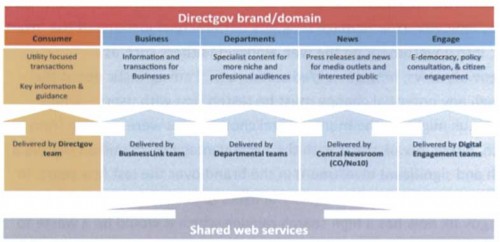When the Lane Fox review proposed ‘a new central team in Cabinet Office in absolute control of the overall user experience across all digital channels, commissioning all government online information from other departments’, we may all have misread it. There’s a must-read comment on Steph Gray’s post reviewing the review by Tom Loosemore, who played in a role in the review. He writes:
The *last* thing that needs to happen is for all online publishing to be centralised into one humungous, inflexible, inefficient central team doing everything from nots to bolts from a bunker somewhere deep in Cabinet Office. The review doesn’t recommend that. Trust me! It does, as you spotted, point towards a model which is closer to the BBC – a federated commissioning approach, where ‘commissioning’ is more akin to the hands-off commissioning of a TV series, rather than micro-commissioning as per a newspaper editor.
With that one contribution, the proposal is cast in a very different light. And maybe it isn’t as crazy as it all sounded this morning. Sighs of relief all round.
I do firmly believe that there are appropriate role models, and appropriate technical solutions, to allow government web publishing to be consolidated satisfactorily – for all concerned. Yes, the BBC is a fine example, but Whitehall already has its own examples. BIS has done it – see a PQ answer, coincidentally published the same day as the review, in which it rightly trumpets the savings made by bringing all its partner organisations on to the same platform, under the same ‘unifying navigation bar’. (And among my own clients, Defra is on its way to doing it.)
It’s easy to imagine a WordPress1 multisite install, with Super Admin rights kept to a central team, a few custom (and customisable) themes, and a carefully selected set of plugins. Child site administrators wouldn’t be permitted to add new code; but would still have considerable freedom within those permitted boundaries. The themes (and indeed, WordPress itself) would enforce certain technological standards and methods, including – you’d imagine – a family bar across the top of each screen, a standard layout, the same font, good and consistent accessibility approaches, etc etc.
So in principle, yes, it’s absolutely possible… and could meet all four Lane Fox objectives. I dearly hope it can. But I share the mild scepticism of Steph Gray’s concluding paragraph: ‘There’s much to like in Martha’s report, and a real opportunity to make things better. If it’s done right.’ The thing is, twice in the past decade, with DotP and then The Club, it’s been tried – and since everyone still isn’t on a shared platform, you have to conclude it was done wrong.
This new vision will be dependent on the formation of a centre of genuine expertise, whether ‘absolute’-ly powerful or not, in the Cabinet Office. The same Cabinet Office who produced the report as a 5.7MB graphic-based PDF file, whose text was neither searchable nor selectable (for which, to give him his dues, Tom Loosemore has apologised – ‘no excuse’). The same Cabinet Office whose own news ‘child’ website failed to even mention the review’s publication (since corrected). So, some way to go, you’d have to say.
[blackbirdpie url=”http://twitter.com/demsoc/status/7007089071235072″]
And I wonder whether it ultimately requires a dramatic culture change of abandoning separate Departmental identities, including separate press operations. Francis Maude sat on the report for a very long time, before eventually publishing it (apparently) unaltered. Did he find it a tough sell to his ministerial colleagues? That would certainly explain why the response has been to form a new ministerial committee.
The Directgov CEO is walking out. So is the government CIO, explicitly named as the one to lead the development of the shared platform. Not to mention the retiring Director of Digital Engagement. So, to whoever finds this landing on their desk… I wish you good luck. And I assure you, there remains a lot of goodwill ‘out here’.
1 I’m sure it would be possible to do likewise on any number of other CMSes, but I doubt any are quite as good as WordPress at providing flexibility to the child site admins.
 I’m told that Cabinet Office Efficiency and Reform Group chief Ian Watmore confirmed the appointment of Chris Chant as Director for Directgov and Digital Engagement in an all-staff email earlier this week. No mention of the word ‘interim’, as I understand it. We knew about the Directgov bit… but the news that he’s the new Andrew Stott is something of a surprise, given Chris’s almost exclusively technical background.
I’m told that Cabinet Office Efficiency and Reform Group chief Ian Watmore confirmed the appointment of Chris Chant as Director for Directgov and Digital Engagement in an all-staff email earlier this week. No mention of the word ‘interim’, as I understand it. We knew about the Directgov bit… but the news that he’s the new Andrew Stott is something of a surprise, given Chris’s almost exclusively technical background.